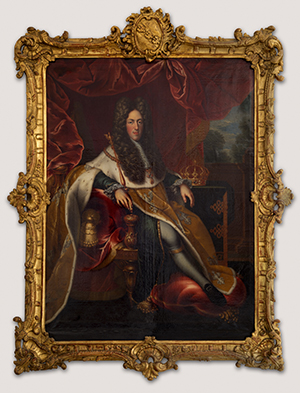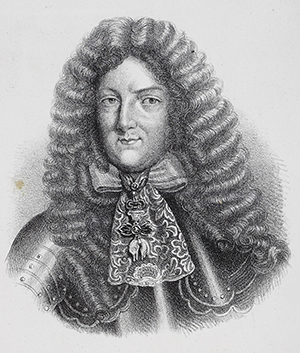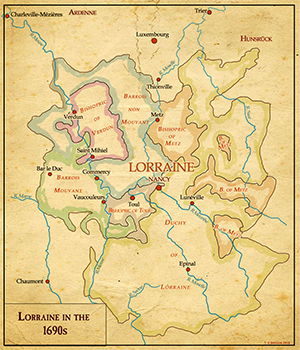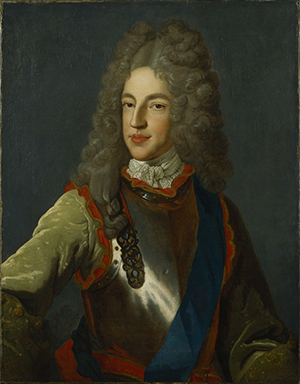‘Irlandois de Nation’
Published in Early Modern History (1500–1700), Features, Issue 3 (May/June 2018), Volume 26Duke Leopold’s Irish subjects and Jacobitism in Lorraine, 1698–1727.
By Stephen Griffin and Jérémy Filet

Above: Leopold I, duke of Lorraine (1679–1729), by Nicholas Depuy, 1703. (Lorraine Museum, Nancy)
Irish networks

Above: Francis Taaffe, 3rd earl of Carlingford (1639–1704), Duke Leopold’s most prominent minister. (NLI)
To do so, the state implemented policies that encouraged migration from all over Europe, most notably in the suppression of the droit d’aubaine, which foreigners were required to pay in France. Carlingford also oversaw the establishment of a college of Irish Franciscans at Boulay near Metz and the enlistment of Irishmen from the French service into the duke’s army. Pressure from William III’s government in London had caused the French to disband and reorganise the Stuart army that had arrived on the Continent after the Treaty of Limerick in 1691. Regiments were amalgamated and restructured and numerous soldiers demobilised. Men stationed on the Rhine at the war’s end quickly found employment in the duke of Lorraine’s service. Edward Warren’s regiment was in Luxembourg when he met Carlingford en route to Lorraine. He enlisted, receiving a commission in the duke’s artillery. Owen O’Rourke from the defunct Regiment de Limerick approached Carlingford and was commissioned as a captain in Leopold’s regiment of guards.
The ducal guard contained a notable percentage of Irishmen. Carlingford was colonel, with O’Rourke as captain, along with Carlingford’s nephew, Charles Throckmorton. A French mémoire from 1702 noted that many of the regimental subalterns were Irish, and regimental payrolls up to at least 1712 reveal a strong contingent of enlisted men with Irish names in O’Rourke’s company. Once these men settled in Lorraine, their families and dependants followed, bringing with them their livelihoods. Individuals and families bearing the names Bourke, Butler, Coughlan, Macdonagh, Madden, O’Connor, O’Gara, O’Kelly and O’Rourke established themselves in the duchy’s capital at Nancy as soldiers, merchants, servants and other such trades. What emerges is a network of people interconnected through family, friendship and acquaintance through the army.
The Taaffes remained at the centre of this, with their cousins the Throckmortons and Plunketts. Owen O’Rourke and Charles O’Gara were also close to the Taaffes. These families in turn kept Irish servants: Carlingford’s secretary was named McSweeny, while O’Rourke’s valet was Farrell Konnely. In his powder factory at Nancy, Edward Warren would also employ local men such as George Coates, Michel Dwyer, John Sullivan and Charles Dieudonné Roë, son of another old emigré from the Stuart army, Charles Roë. Further evidence reveals their friendships and kinships, as they attended civil events together, as witnesses to each other’s marriages, the baptisms of their children and the signing of wills. Cornelius O’Sullivan, one of Leopold’s bodyguard, was present at the wedding of Charles Coughlan in 1707. Edmond O’Kelly, lieutenant of the duke’s guards, was similarly present at the wedding of Leopold’s groom, Pierre Taaffe, in 1709.
Le ‘Versailles Lorrain’
 Leopold’s court was initially in the ducal palace at Nancy. The French invasion of Lorraine, however, forced the duke to refurbish the Château de Lunéville, just south of the city, and after 1704 it became a permanent residence. The court was highly diverse, containing Irish, French, Germans, Italians, English, Czechs and Hungarians in addition to the Lorrainers.
Leopold’s court was initially in the ducal palace at Nancy. The French invasion of Lorraine, however, forced the duke to refurbish the Château de Lunéville, just south of the city, and after 1704 it became a permanent residence. The court was highly diverse, containing Irish, French, Germans, Italians, English, Czechs and Hungarians in addition to the Lorrainers.
Until his death in 1704 Carlingford served as Leopold’s chief minister, in receipt of some 36,000 livres a year (more money than was allotted to the duke’s wife, Élisabeth Charlotte d’Orléans, and almost half of all expenses, totalling 75,897 livres, in Leopold’s court). He secured positions in the ducal household for his relatives. His cousin Nicholas Taaffe (6th earl of Carlingford) was raised there, and his nephew Theobald (4th earl of Carlingford) was first gentleman of the bedchamber. Carlingford’s niece, Anne-Marguerite Throckmorton (sister to Charles in the regiment of guards), was appointed to the duchess’s household. In addition, Owen O’Rourke would become chamberlain and counsellor of state, and Richard Butler, Charles O’Gara and Charles Throckmorton would all serve as chamberlains at different times.
Admission to the local nobility

Above: James Francis Edward Stuart (1688–1766), the ‘Old Pretender’, while in exile at Bar-le-Duc from 1713 to 1716, where he went by the name of the Chevalier de St-Georges, by Alexis Simon Belle. (NPG, London)
To be noble in Lorraine one had to prove one’s status. The Irish stuck in Europe after 1691 required proof of noble lineage and frequently contacted the Athlone Herald, James Terry, at the Stuart court in exile at St-Germain-en-Laye, to provide them with the necessary documents. In 1700 the Stuart court supplied Cornelius O’Sullivan with such a certificate, and in 1704 they did so again for Edmond O’Kelly, the lieutenant in the ducal guard. The O’Kelly case was brought before the Chambre des Comptes and both Carlingford and Owen O’Rourke were required to verify that the signature on O’Kelly’s certificate was that of the head of the Stuart court in exile, known to the Jacobites as James III and to his detractors as the Pretender. Eventually the court ruled in favour of O’Kelly but warned that by granting him this they would be encouraging many more Irishmen (a lot of whom could not possibly be gentlemen) to attempt to establish themselves as part of Lorraine’s nobility.
Another clash arose in 1708 when Owen O’Rourke attempted to marry Catherine Diane de Beauvau, sister of Leopold’s most prominent courtier, Marc de Beauvau-Craon. Catherine Diane had been married twice before to men from Lorraine’s old nobility, and the prospect of a union with O’Rourke outraged her family. Her brother appealed to Leopold and O’Rourke was sent away to Paris in the winter of 1708. In Paris, O’Rourke had a certificate drawn up and signed by a number of high-profile Irishmen based in the city. Once they signed the certificate at St-Germain-en-Laye it was presented to the herald, Terry. O’Rourke and Catherine Diane were married shortly thereafter in April 1709. This did not go down well with the bride’s family and it would not be until 1711 that Madame O’Rourke was reconciled with them. The marriage eventually allowed O’Rourke to claim the title of his wife’s second husband and he became the Comte de Couvonges in 1727.
‘Chevalier de St-Georges’
In accordance with the Treaty of Utrecht in 1713 James III had been obliged to depart France, and thereafter dwelt in Lorraine between 1713 and 1715. The move was made with the consent of Leopold, Louis XIV, Emperor Charles VI and the British government. Under the alias of the Chevalier de St-Georges, James was housed in the town of Bar-le-duc, the capital of Bar, the eastern side of which—the Barrois non-mouvant—was under Leopold’s jurisdiction, whereas the western Barrois mouvant was considered by the French monarchs as theirs, though it was the duke’s territory. James was initially welcomed by the marquis de Bassompierre and Owen O’Rourke. Four companies of foot guards with men bearing names such as Barry, Brady, Brendon and Coughlan were stationed at Bar to protect the ‘chevalier’s’ house, and one of the commanders was Richard Butler. An additional guard of 30 men was assigned to be on duty there at all times. Three footmen and five grooms accompanied the chevalier from St-Germain—Andrew Symes, John Noel, Jacques Catillon, Patrick Maguirk, Francis Ridge, Mark Manning, John Owens and Roger Ryan. Irish and British servants were also appointed by Leopold to key positions in the house; Charles and François L’Anglois were to be his housekeepers in Bar, and Guillaume and Jean L’Anglois were members of the chevalier’s hunting staff.
Many other Irish soldiers from the duke’s army also went to visit Bar during this period. Odly Macdonough, officer of the guards, is known to have visited, as did Cornelius O’Donovan, a captain-major of the Nancy regiment of guards. The O’Donovan family, whether by coincidence or intent, moved to Bar-le-Duc shortly after James III settled there in 1713. Edward Warren, by then in charge of Lorraine’s heavy artillery, and Barthelemy Plunkett, a brigadier of the Stainville company, visited the chevalier in Bar as well. Some of those who visited Bar, such as the O’Garas and O’Briens, also had strong family connections with the court in St-Germain.
The chevalier’s presence in Lorraine put Leopold on the receiving end of anti-Jacobite propaganda, as pamphleteers referred to him as Le Petit Lorrain. Leopold contributed about 308,000 livres to the Stuart coffers during the three years they spent in his domain. In addition, the duke appears to have given the chevalier a secret loan of 25,000 louis d’or at the time of the Jacobite rebellion of 1715. Edward Warren also manufactured fireworks to be displayed for James at Bar-le-duc, a welcome display of magnificence at the exiled prince’s court.
Lorraine and beyond
Overall, the Irish in Lorraine remained well connected with their fellow countrymen in Europe, especially in France and the empire. Many of them would ultimately follow Leopold’s sons to Vienna in the 1730s, while others remained in Lorraine. The community which settled around Carlingford in the early years of Leopold’s reign counted numerous families with strong links to the regiments in France and a notable attachment to the Stuart court. Some of the most prominent members of the Irish community in Lorraine, such as Edward Warren or Owen O’Rourke, made the most out of their settlement in the duchy. Warren had links with many of the Irish and British of the duchy, and his commercial connections extended as far as Rotterdam via the Cork merchant John Goddard. Owen O’Rourke maintained an active involvement in the Jacobite cause, particularly from the 1710s onwards, and represented the Stuarts in Vienna between 1727 and 1743. Today there are not many physical reminders of the Irish settlement in Lorraine. The hotel d’Rourke for example, was demolished in the nineteenth century, but in Nancy one can still find descendants of the Irish who settled there, bearing surnames such as Obrien, Conor and Bary.
Stephen Griffin is a Ph.D candidate at the University of Limerick; Jérémy Filet is a joint Ph.D candidate at the Université de Lorraine and Manchester Metropolitan University.
Read More:
Lorraine — a brief history
FURTHER READING
- E. Corp, A court in exile: the Stuarts in France, 1689–1718 (Cambridge, 2004).
- N. Genet-Rouffiac, Le grand exil: les Jacobites en France, 1688–1745 (Paris, 2007).
- A. Motta (ed.), Échanges, passages et transferts à la cour du duc Léopold (1698–1729) (Nancy, 2017).
- F. Richard-Maupillier, ‘The Irish in the regiments of Duke Leopold of Lorraine, 1698–1729’, Archivium Hibernicum 67 (2014), 285–312.
















